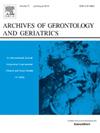AWGS 2019指南中可能的肌肉减少症算法中,哪一条途径对韩国社区老年男性和女性最好?
IF 3.5
3区 医学
Q2 GERIATRICS & GERONTOLOGY
引用次数: 0
摘要
目的比较2019年亚洲肌肉减少症工作组(AWGS)提出的可能的肌肉减少症识别途径在韩国社区老年人中按性别的诊断准确性。设计对2129名社区居住成年人(70-84岁,50.4%男性)参加韩国衰弱和衰老队列研究的数据进行横断面分析。方法根据AWGS 2019指南,通过低握力(HGS)或慢5次椅站测试(5CST)时间(称为“评估”)来定义可能的肌肉减少症。在评估前,推荐“病例-发现”(低小腿围[CC]、SARC-F≥4或SARC-CalF≥11)筛查“可能的肌肉减少症”。对于六种“可能的肌肉减少症”途径(结合三种病例发现和两种评估工具),比较曲线下面积(AUC)和F1评分。结果对于男性病例发现,与SARC-F和SARC-CalF相比,CC在预测肌肉减少症方面显示出最高的AUC(0.657)和F1评分(0.504)(p <0.001, =0.001)。在低CC的男性中,ΔAUC在HGS和5CST之间的差异不显著(p=0.079) (auc: 0.763 vs. 0.707;F1得分:0.713 vs. 0.650)。对于女性病例发现,与CC和SARC-F相比,SARC-CalF显示出最高的AUC(0.631)和F1评分(0.389)(p=0.012, <0.001)。随后,女性HGS和5CST之间的ΔAUC差异不显著(p=0.069) (auc: 0.566 vs 0.636;F1得分:0.387比0.514)。根据AWGS 2019指南,男性CC和女性SARC-CalF是社区居住老年人的最佳病例发现工具。在每个性别的最佳病例发现之后,两种评估途径显示男女之间的差异不显著。对于可能的肌少症病例发现,在老年男性中使用小腿围和在老年女性中使用SARC-CalF预测肌少症的诊断准确性最高。在每个性别的最佳病例发现之后,两种可能的肌肉减少的评估途径(握力和五次椅站测试)在男女之间的差异不显著。本文章由计算机程序翻译,如有差异,请以英文原文为准。
Which pathway of the possible sarcopenia algorithm of the AWGS 2019 guideline is the best in Korean community-dwelling older men and women?
Objective
To compare the diagnostic accuracy of possible sarcopenia identification pathways, as suggested by Asian Working Group for Sarcopenia (AWGS) in 2019, by gender among Korean community-dwelling older adults.
Design
Cross-sectional analysis of data from 2,129 community-dwelling adults (70–84 years, 50.4% men) enrolled in Korean Frailty and Aging Cohort Study.
Methods
Based on AWGS 2019 guideline, possible sarcopenia was defined by low handgrip strength (HGS) or slow five-times chair stand test (5CST) time, referred to as “assessments.” “Case-findings” (low calf circumference [CC], SARC-F ≥4, or SARC-CalF ≥11) were recommended for screening ‘possible sarcopenia’ before assessment. For the six ‘possible sarcopenia’ pathways (combining three case-finding and two assessment tools), area under the curve (AUC) and F1 score are compared.
Results
For case-finding in men, CC demonstrated the highest AUC (0.657) and F1 score (0.504) for predicting sarcopenia compared with SARC-F and SARC-CalF (p <0.001, =0.001). Among men with low CC, ΔAUC between HGS and 5CST was not significant as assessment (p=0.079) (AUCs: 0.763 vs. 0.707; F1 scores: 0.713 vs. 0.650). For case-finding in women, SARC-CalF demonstrated the highest AUC (0.631) and F1 score (0.389) compared with CC and SARC-F (p=0.012, <0.001). Subsequently, ΔAUC between HGS and 5CST was not significant in women (p=0.069) (AUCs: 0.566 vs. 0.636; F1 scores: 0.387 vs. 0.514).
Conclusions
Based on AWGS 2019 guideline, CC in men and SARC-CalF in women was the best case-finding tool for community-dwelling older adults. After the best case-finding in each gender, two assessment pathways demonstrated insignificant difference in both genders.
Brief summary
For case-finding of possible sarcopenia, using calf circumference in older men and using SARC-CalF in older women demonstrated the highest diagnostic accuracy for predicting sarcopenia. After the best case-finding in each gender, two assessment pathways (handgrip strength and five-times chair stand test) of possible sarcopenia demonstrated insignificant difference in both genders.
求助全文
通过发布文献求助,成功后即可免费获取论文全文。
去求助
来源期刊
CiteScore
7.30
自引率
5.00%
发文量
198
审稿时长
16 days
期刊介绍:
Archives of Gerontology and Geriatrics provides a medium for the publication of papers from the fields of experimental gerontology and clinical and social geriatrics. The principal aim of the journal is to facilitate the exchange of information between specialists in these three fields of gerontological research. Experimental papers dealing with the basic mechanisms of aging at molecular, cellular, tissue or organ levels will be published.
Clinical papers will be accepted if they provide sufficiently new information or are of fundamental importance for the knowledge of human aging. Purely descriptive clinical papers will be accepted only if the results permit further interpretation. Papers dealing with anti-aging pharmacological preparations in humans are welcome. Papers on the social aspects of geriatrics will be accepted if they are of general interest regarding the epidemiology of aging and the efficiency and working methods of the social organizations for the health care of the elderly.

 求助内容:
求助内容: 应助结果提醒方式:
应助结果提醒方式:


